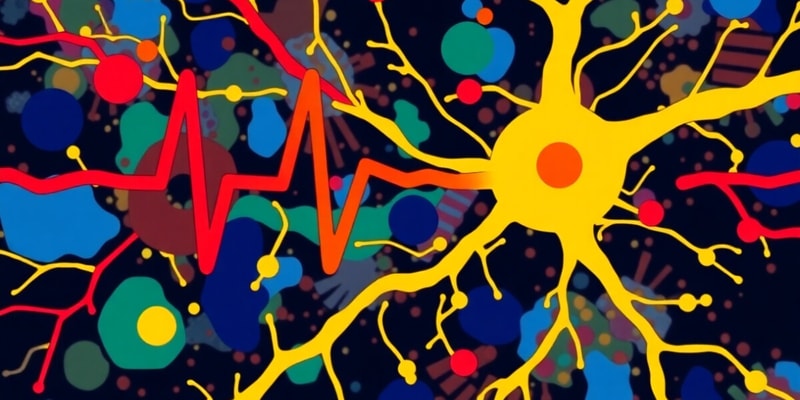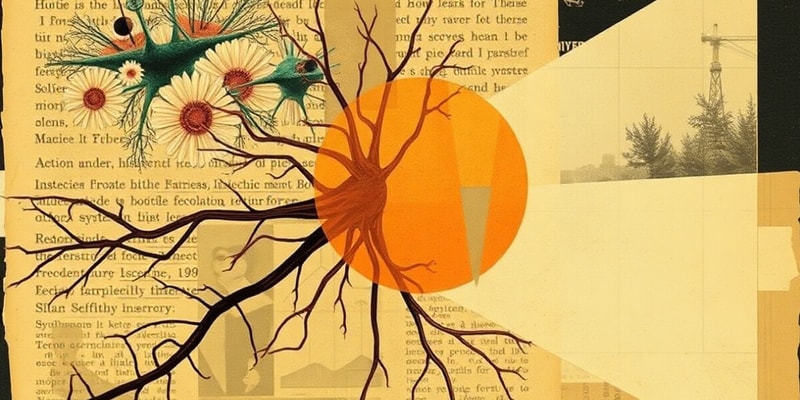Podcast
Questions and Answers
What is the outcome when two EPSPs occur simultaneously?
What is the outcome when two EPSPs occur simultaneously?
How do local anesthetics like Novocaine and Lidocaine function?
How do local anesthetics like Novocaine and Lidocaine function?
What type of potential must occur in high enough frequency to generate an action potential?
What type of potential must occur in high enough frequency to generate an action potential?
What effect does increasing inhibition (IPSP) have when combined with excitation (EPSP)?
What effect does increasing inhibition (IPSP) have when combined with excitation (EPSP)?
Signup and view all the answers
What is a potential consequence of tetrodotoxin (TTX) exposure?
What is a potential consequence of tetrodotoxin (TTX) exposure?
Signup and view all the answers
What defines action potentials in nerve cell axons?
What defines action potentials in nerve cell axons?
Signup and view all the answers
Why do action potentials propagate in one direction along an axon?
Why do action potentials propagate in one direction along an axon?
Signup and view all the answers
What role does the myelin sheath play in nerve physiology?
What role does the myelin sheath play in nerve physiology?
Signup and view all the answers
Which mechanism is involved in synaptic transmission?
Which mechanism is involved in synaptic transmission?
Signup and view all the answers
What distinguishes local anaesthetics from neurotoxins in their mechanism of action?
What distinguishes local anaesthetics from neurotoxins in their mechanism of action?
Signup and view all the answers
What type of cells are responsible for transmitting sensory information?
What type of cells are responsible for transmitting sensory information?
Signup and view all the answers
What is the significance of the time taken for ions to achieve 99% equilibrium in a nerve?
What is the significance of the time taken for ions to achieve 99% equilibrium in a nerve?
Signup and view all the answers
What limits the size of graded potentials in neurons?
What limits the size of graded potentials in neurons?
Signup and view all the answers
What triggers the opening of sodium channels during an action potential?
What triggers the opening of sodium channels during an action potential?
Signup and view all the answers
What happens to the membrane potential during the phase leading to an action potential?
What happens to the membrane potential during the phase leading to an action potential?
Signup and view all the answers
Which condition describes the resting membrane potential?
Which condition describes the resting membrane potential?
Signup and view all the answers
During which phase do voltage-gated sodium channels play a critical role?
During which phase do voltage-gated sodium channels play a critical role?
Signup and view all the answers
What is the effect of increased sodium concentration inside the axon?
What is the effect of increased sodium concentration inside the axon?
Signup and view all the answers
What defines graded potentials in a neuron?
What defines graded potentials in a neuron?
Signup and view all the answers
Which event occurs first after the membrane potential reaches -55 mV?
Which event occurs first after the membrane potential reaches -55 mV?
Signup and view all the answers
What is the role of potassium (K+) channels during action potentials?
What is the role of potassium (K+) channels during action potentials?
Signup and view all the answers
How is the membrane potential at -70 mV characterized?
How is the membrane potential at -70 mV characterized?
Signup and view all the answers
What occurs at the decision point of an action potential?
What occurs at the decision point of an action potential?
Signup and view all the answers
What is the primary effect of opening voltage-gated Na+ channels on the neuron's membrane potential?
What is the primary effect of opening voltage-gated Na+ channels on the neuron's membrane potential?
Signup and view all the answers
What is the result of K+ ions leaving the cell when K+ channels are open?
What is the result of K+ ions leaving the cell when K+ channels are open?
Signup and view all the answers
How quickly does the fast excitatory response occur upon the opening of Na+ channels?
How quickly does the fast excitatory response occur upon the opening of Na+ channels?
Signup and view all the answers
What characterizes an excitatory post-synaptic potential (EPSP)?
What characterizes an excitatory post-synaptic potential (EPSP)?
Signup and view all the answers
What is the role of iberiotoxin in the context of K+ channels?
What is the role of iberiotoxin in the context of K+ channels?
Signup and view all the answers
Which response is described as occurring slowly due to ligand binding and conformational changes?
Which response is described as occurring slowly due to ligand binding and conformational changes?
Signup and view all the answers
What does the hyperpolarization in a post-synaptic cell indicate?
What does the hyperpolarization in a post-synaptic cell indicate?
Signup and view all the answers
What is the rate at which Na+ ions can enter the cell when Na+ channels open?
What is the rate at which Na+ ions can enter the cell when Na+ channels open?
Signup and view all the answers
What is the main mechanism of action associated with ionotropic responses?
What is the main mechanism of action associated with ionotropic responses?
Signup and view all the answers
Which of the following primarily leads to an increase in voltage across the membrane rapidly?
Which of the following primarily leads to an increase in voltage across the membrane rapidly?
Signup and view all the answers
What happens to the graded potential at the axon hillock when the stimulus on a sensory cell ceases?
What happens to the graded potential at the axon hillock when the stimulus on a sensory cell ceases?
Signup and view all the answers
Why do action potentials propagate in one direction along nerve cell axons?
Why do action potentials propagate in one direction along nerve cell axons?
Signup and view all the answers
What effect would blocking voltage-gated Na+ channels have on nerve impulses?
What effect would blocking voltage-gated Na+ channels have on nerve impulses?
Signup and view all the answers
Which of the following best describes the role of neuroglia and the myelin sheath in the context of action potentials?
Which of the following best describes the role of neuroglia and the myelin sheath in the context of action potentials?
Signup and view all the answers
What is a direct consequence of a graded potential falling below -55 mV?
What is a direct consequence of a graded potential falling below -55 mV?
Signup and view all the answers
How do local anaesthetics function within the neural pathway?
How do local anaesthetics function within the neural pathway?
Signup and view all the answers
What is the relationship between synapses and neuronal circuits?
What is the relationship between synapses and neuronal circuits?
Signup and view all the answers
What would be the impact of reducing the number of synapses in a neuronal circuit?
What would be the impact of reducing the number of synapses in a neuronal circuit?
Signup and view all the answers
What mechanism underlies synaptic transmission in the nervous system?
What mechanism underlies synaptic transmission in the nervous system?
Signup and view all the answers
Which scenario best describes the resting state of a neuron?
Which scenario best describes the resting state of a neuron?
Signup and view all the answers
Study Notes
Action Potentials
- Action potentials are generated by the movement of ions across the cell membrane.
- They are rapid changes in membrane potential.
- The movement of ions is facilitated by voltage-gated sodium and potassium channels.
- Sodium ions flow into the cell during depolarization.
- Potassium ions flow out of the cell during repolarization.
Propagation of Action Potential
- Action potentials propagate in one direction because of the refractory period.
- The refractory period is a brief period of time after an action potential when the neuron cannot fire another action potential.
- This is because the sodium channels are inactivated after they open.
- The refractory period ensures that the action potential travels in one direction.
Role of Neuroglia and Myelin Sheath
- Neuroglia are supporting cells that play a crucial role in the nervous system.
- They provide structural support, nourishment, and insulation for neurons.
- Myelin sheath is a fatty substance that insulates axons, speeding up the conduction of action potentials.
Synaptic Transmission
- Synaptic transmission is the communication between neurons.
- Neurotransmitters are released from the presynaptic neuron and bind to receptors on the postsynaptic neuron.
- There are two types of synaptic transmission:
- Fast - mediated by ion channels and occurs very quickly.
- Slow - mediated by second messenger systems and occurs more slowly.
- Excitatory postsynaptic potentials (EPSPs) increase the likelihood of an action potential occurring in the postsynaptic neuron.
- Inhibitory postsynaptic potentials (IPSPs) decrease the likelihood of an action potential occurring in the postsynaptic neuron.
Local Anaesthetics
- Local anaesthetics (e.g. novocaine, lidocaine) block voltage-gated sodium channels.
- This prevents action potentials from being generated, resulting in pain relief.
- They have a local effect on neurons, preventing pain signals from reaching the brain.
Neurotoxins
- Neurotoxins (e.g. tetrodotoxin) block voltage-gated sodium channels.
- This prevents nerve impulses from being sent, leading to paralysis.
- Tetrodotoxin is a very potent neurotoxin and can be fatal.
- Tetrodotoxin is found in pufferfish.
Studying That Suits You
Use AI to generate personalized quizzes and flashcards to suit your learning preferences.
Related Documents
Description
This quiz covers the fundamentals of action potentials in neurons, including their generation, propagation, and the roles of neuroglia and the myelin sheath. Test your knowledge on the ion movements, depolarization, and the refractory period vital for neuronal signaling.



